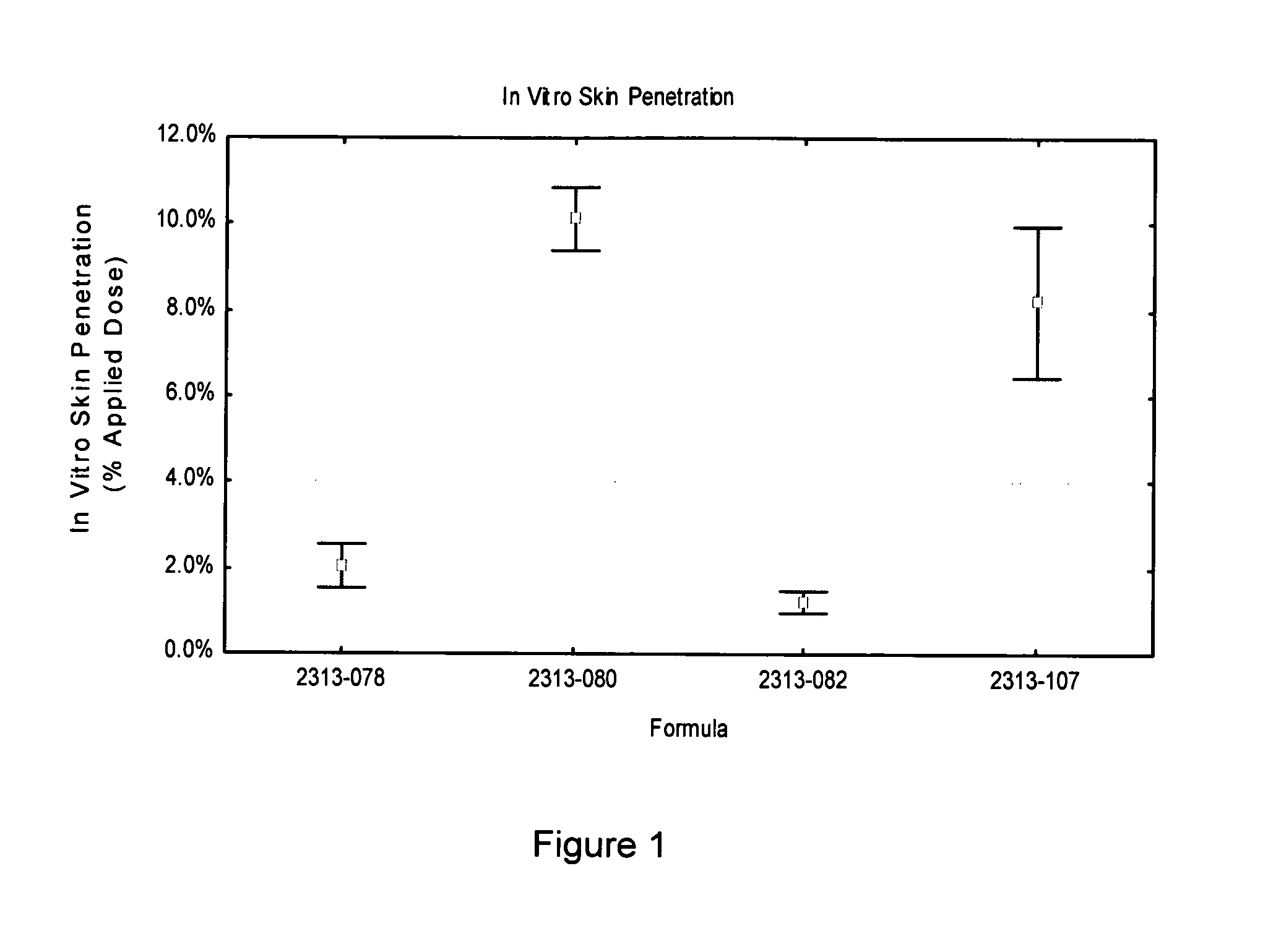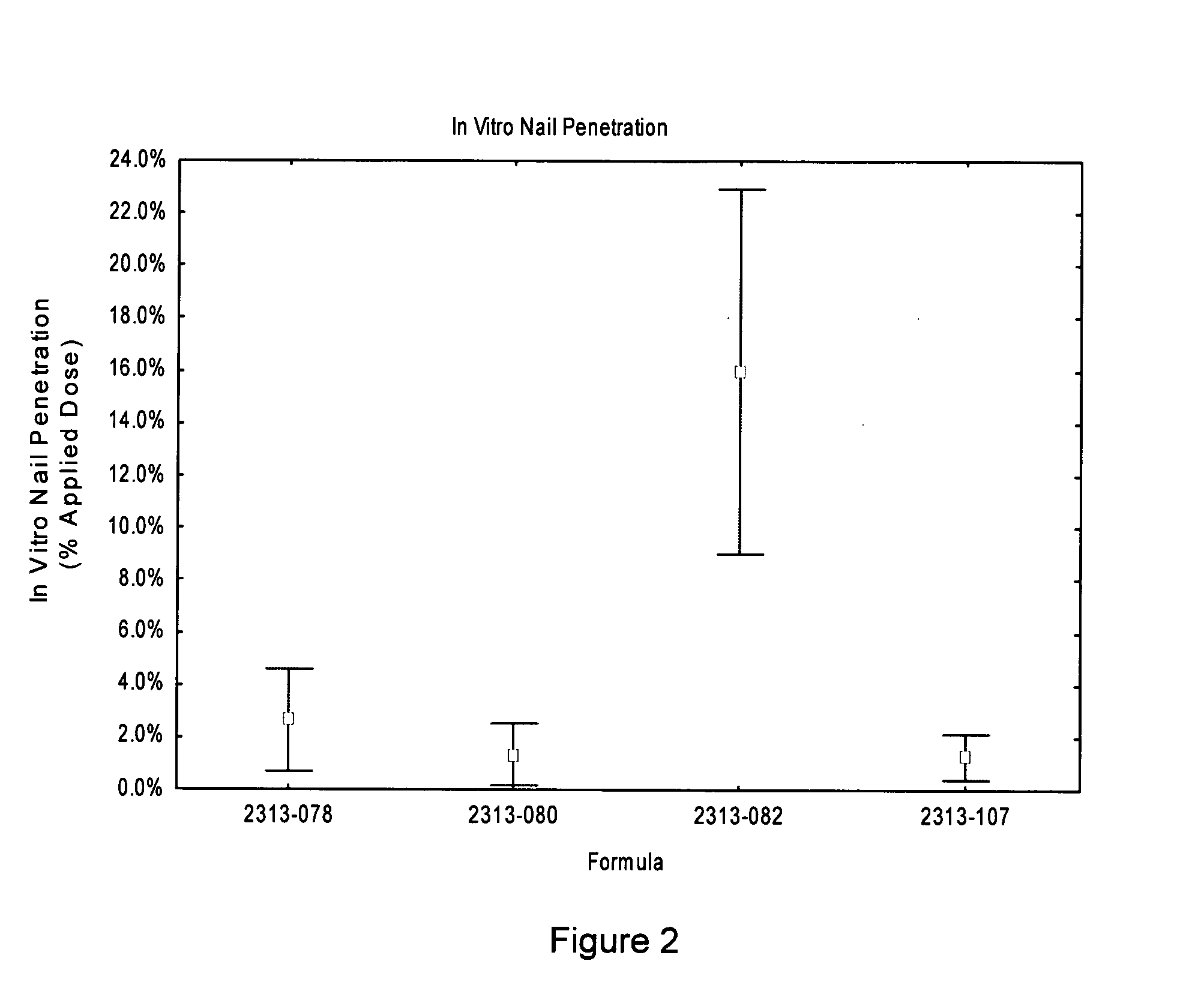Compositions and methods for treating diseases of the nail
a technology of compositions and methods, applied in the field of nail and nail bed diseases, can solve the problems of affecting the delivery of topical drugs, none of these methods have been consistently effective in treating, and not shown to be clinically effective in treating nail conditions
- Summary
- Abstract
- Description
- Claims
- Application Information
AI Technical Summary
Problems solved by technology
Method used
Image
Examples
example 1
Skin Penetration Study
[0062]Four different formulations were tested to determine the penetrability of an API into skin. The formulations each contained 5.00% w / w of a triazole antifungal API compound, KP-103. The compositions of the four formulations are shown in Table 2. All concentrations of the components of the formulations are in % w / w.
[0063]
TABLE 2Formulation No.078080082107KP-1035.005.005.005.00alcohol19.3520.0059.998—triacetin15.00———glycerin35.00 24.998——1,3-butylene glycol25.00———carbomer 9800.50———diisopropanolamine0.10———Vitamin E0.050.0020.0020.05propylene glycol—50.00——cyclomethicone——13.00—diisopropyl adipate——12.008.20myristyl lactate——10.00—isopropyl myristate———5.48white petrolatum———51.27urea———30.00
[0064]Each of the formulations of Table 2 was spiked with tracer amounts of radiolabeled KP-103 at approximately 0.90 μCi / dose. A single clinically relevant dose (5 mg / cm2) was applied to dermatomed human skin obtained from one donor following elective surgery.
[0065]Pe...
example 2
Nail Penetration Study
[0067]The formulations 078, 080, 082, and 107 of Example 1 were tested to determine penetration of the API from the formulation into and through nail plates. Each of the formulations of Table 2 was spiked with tracer amounts of radiolabeled KP-103 at approximately 0.90 μCi / dose. A clinically relevant protocol was followed, which entailed dosing 10 μL / cm2 per day for 14 days onto healthy human finger nail plates, which were obtained from multiple donors.
[0068]Nail penetration was evaluated by mounting the finger nail plates into custom diffusion cells. Five replicates were performed for each formulation. A small cotton ball wetted with 0.1 mL normal saline was used as a receptor. For each day of the study, the surface of the nail was washed, and 10 μL of formulation was applied to the surface. Every second day, the cotton ball receptor was replaced. After fourteen days of exposure, the nail plate was sectioned into three sections, a central dorsal (upper) sectio...
example 3
Clinical Assessment in Animal Model of Onychomycosis
[0070]The efficacy of a formulation of the invention, Formulation 087, containing 3.00% w / w of a triazole antifungal API, KP-103, was evaluated in an animal model of onychomycosis and, in two separate studies, was compared with that of several commercial products intended for the treatment of onychomycosis. The composition of Formulation 087 is shown in Table 3.
[0071]
TABLE 3FORMULATION 087ComponentConcentration (% w / w)KP-1033.00Alcohol60.00Vitamin E0.002Cyclomethicone13.00Diisopropyl adipate10.00Myristyl lactate13.998
[0072]In order to test the efficacy of Formulation 087 and the comparison products, onychomycosis was induced in six-week old Hartley guinea pigs. Each of Formulation 087 and the comparison products were tested in five animals. Two hundred (200) μL of a suspension of Trichophyton mentagrophytes SM-110 (1×108 arthrospores / mL) was inoculated to the plantar and interdigital skin of the hind paws, and the entire feet were ...
PUM
| Property | Measurement | Unit |
|---|---|---|
| Length | aaaaa | aaaaa |
| Volume | aaaaa | aaaaa |
| Surface tension | aaaaa | aaaaa |
Abstract
Description
Claims
Application Information
 Login to View More
Login to View More - R&D
- Intellectual Property
- Life Sciences
- Materials
- Tech Scout
- Unparalleled Data Quality
- Higher Quality Content
- 60% Fewer Hallucinations
Browse by: Latest US Patents, China's latest patents, Technical Efficacy Thesaurus, Application Domain, Technology Topic, Popular Technical Reports.
© 2025 PatSnap. All rights reserved.Legal|Privacy policy|Modern Slavery Act Transparency Statement|Sitemap|About US| Contact US: help@patsnap.com



